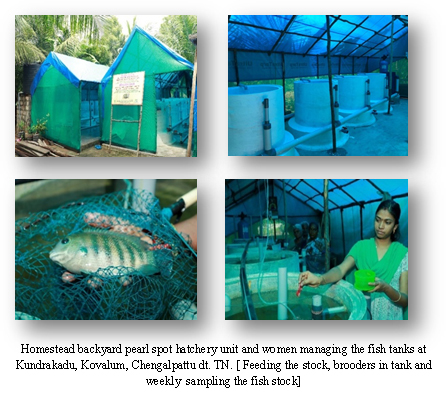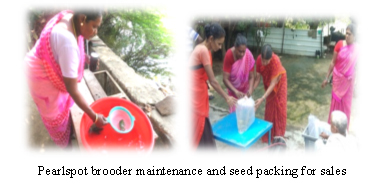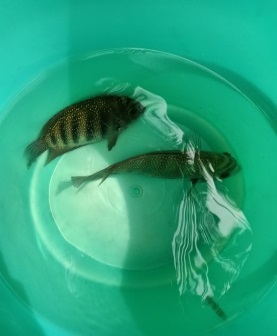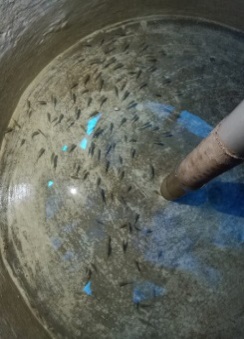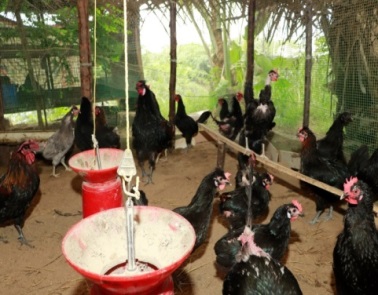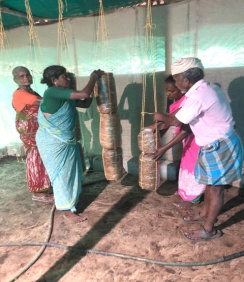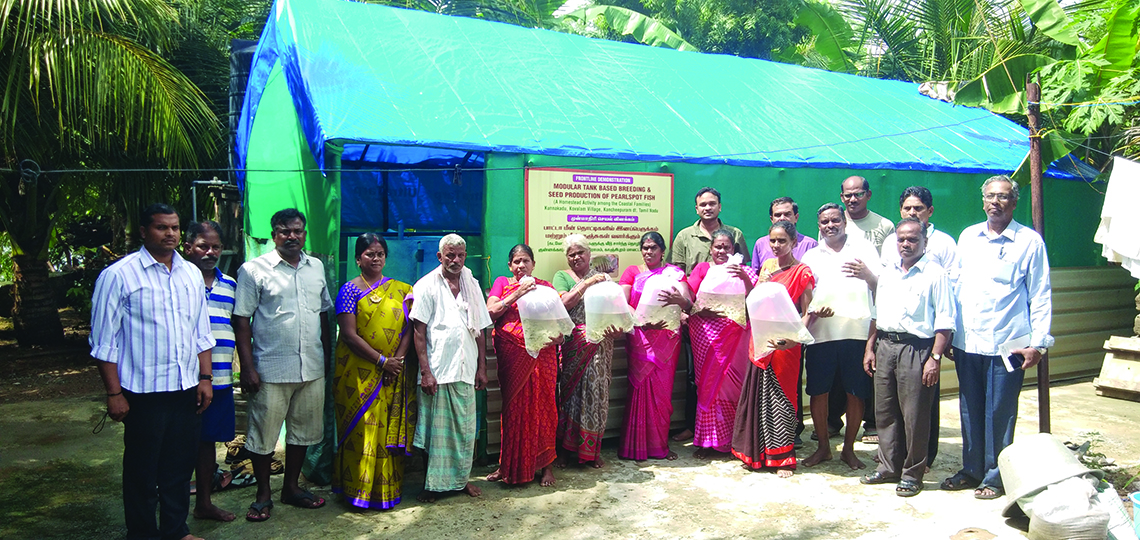A batch of coastal families in Kundrakadu hamlet of Kovalam village, Chengalpattu district, Tamil Nadu were engaged in clam collection in the Kovalam backwaters as a livelihood activity along with fishing. However, aftermath of the Indian Ocean Tsunami occurred during December 2004 the clam resources dwindled drastically in the backwaters which had adversely affected their livelihoods. Since they have the skill sets of collecting clams and fish in coastal waters they looked for an aquaculture based avocation suiting to their capacity. They approached ICAR-CIBA for guidance and facilitation for an alternative livelihood. CIBA in convergence with Chennai Petroleum Corporation Limited (CPCL) implemented a project under Corporate Social Responsibility (CSR) of CPCL of Madras Refineries Limited (MRL). The project team organised them as a group (10 members) to take up a brackishwater aquaculture activity and trained them to establish a customised homestead Recirculatory Aquaculture System (RAS) for pearl spot fish (Etroplus suretensis) larval rearing. In addition to that poultry rearing, mushroom production and kitchen garden units were also established as an integrated set up to provide adequate employment and income to the group members.
Pearl spot seed rearing activity involved (1) stocking of pearl spot fry size seed in the modular tanks (2) feed preparation and feeding (3) tank cleaning and maintenance (4) monitoring the fish growth (5) harvesting and packing the fingerlings (6) marketing to local ornamental fish farmers and traders. Two thousand numbers of pearl spot fry, with the an average size of 1.0 cm (range 0.8 cm to 1.2 cm) were provided from the CIBA fish hatchery and stocked @ 500 nos each in 4 concrete tanks. Feeding was done with CIBA Pearl spot GrowoutPlus feed @ 3-5% of body weight on daily basis. After 52 days of culture, the fish had attained the average weight of 0.8 g (0.6g to 1.1 g) with an average size of 3.2 cm (range of 2.8 – 3.6 cm.). A total of 1,865 pearl spot fingerlings were harvested, indicating a successful nursery phase with the survival rate of 93.3%. The cost of production was worked out to be Rs. 2500/-(seed cost @ Re. 1.0/-seed and feed cost Rs.500/-). The fingerlings were sold @ Rs.6/fingerling to ornamental fish farmers. The group earned an income of Rs. 9000 per batch from pearl spot seed rearing technology. The drain from the larval rearing tanks was used for growing vegetables in the kitchen garden.
During the pearl spot seed rearing technology adoption the beneficiaries were simultaneously trained on Pearl spot seed production technology at CIBA fish hatchery. Subsequently, the group collected 40 nos. of Pearl spot brooders (50 g to 80 g in weight) from the wild at the Pulicate lake backwaters (Kannavanthurai tribal village) in Tiruvallur district of Tamil Nadu. The brooders were quarantined in CIBA fish hatchery for 20 days for pairing and brought to the beneficiaries’ RAS based homestead modular tanks set up.
The tank reared pearl spot brooders bred during the month of June 2020 and they obtained 130 early fry. This fry was reared and the fingerlings would be sold to the ornamental fish farmers. To continue this cycle an arrangement was made by which a tribal beneficiary group at Kanavanthurai tribal village to supply the pearl spot brooders from Pulicat Lake continuously to the beneficiary group at Kundrakadu, Kovalam for seed production and larval rearing.
In addition to the pearl spot nursery rearing, the beneficiaries have also earned an income of Rs. 10,000/- to Rs.12,000/- from the sale of backyard poultry and Rs. 5,000/- to Rs.6,000/- from homestead backyard vegetable farming. The profit earned from the sales of fish, poultry and vegetables from kitchen garden are deposited in their joint bank account operated by the office bearers and is shared among the group members. The adoption of “Homestead Backyard Pearl spot Breeding and Seed Rearing Activity” along with poultry farming and kitchen gardening has provided them livelihood opportunity to the clam collecting coastal families. This programme was undertaken by a team of scientists consisted of Dr. B. Shanthi, Principal Scientist & Principal Investigator of the CIBA-CPCL Project and Dr M Kailasam, HOD, Fish Culture Division of ICAR-CIBA, Dr. C.V.Sairam, PS & SIC Social Sciences Division, Dr. Krishna Sukumaran Senior Scientist, Fish Culture Division, Shri T. Sivaramakrishnan Scientist, Nutrition Genetics and Biotechnology Division, and G.Thiagarajan, Senior Technical Assistant.
